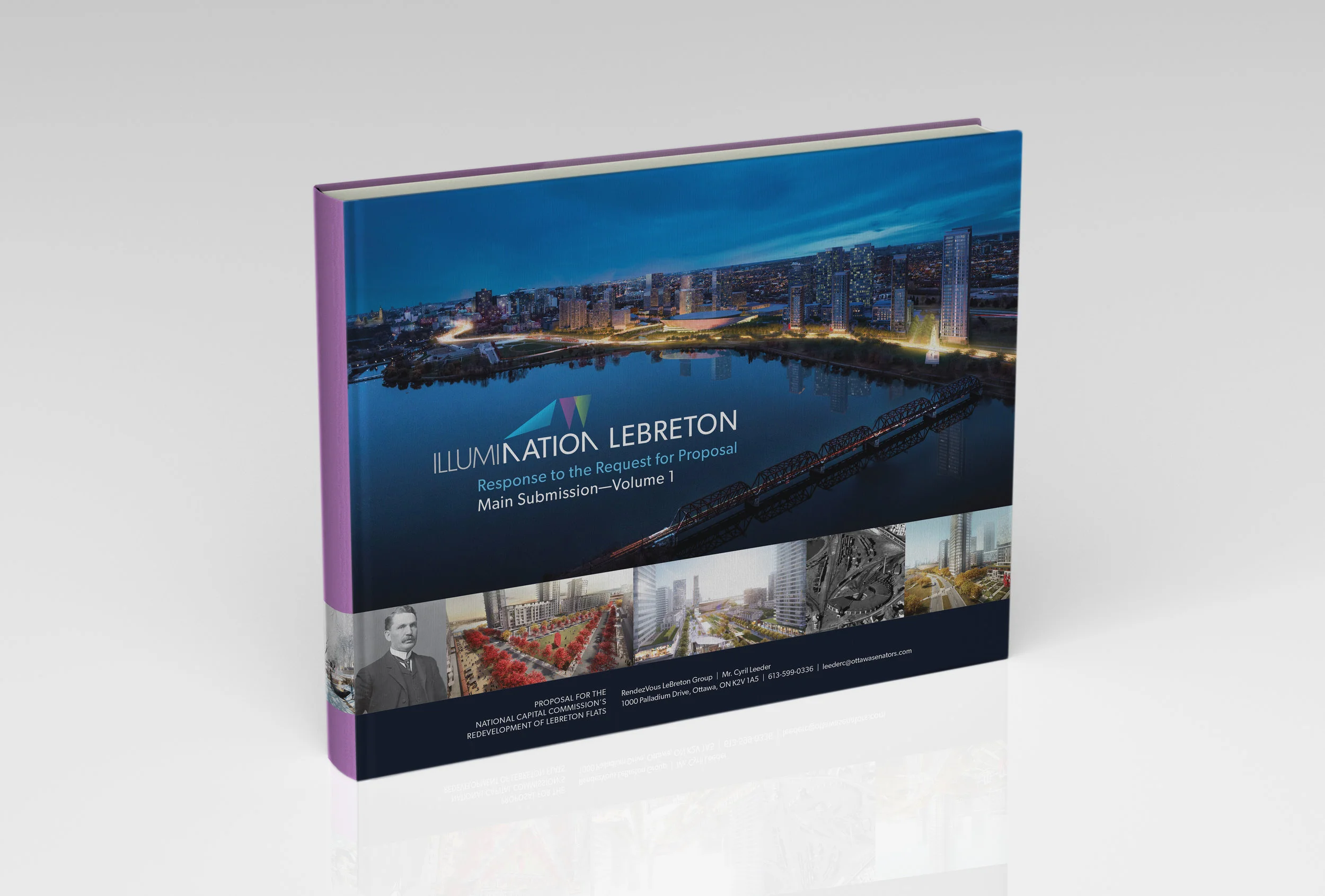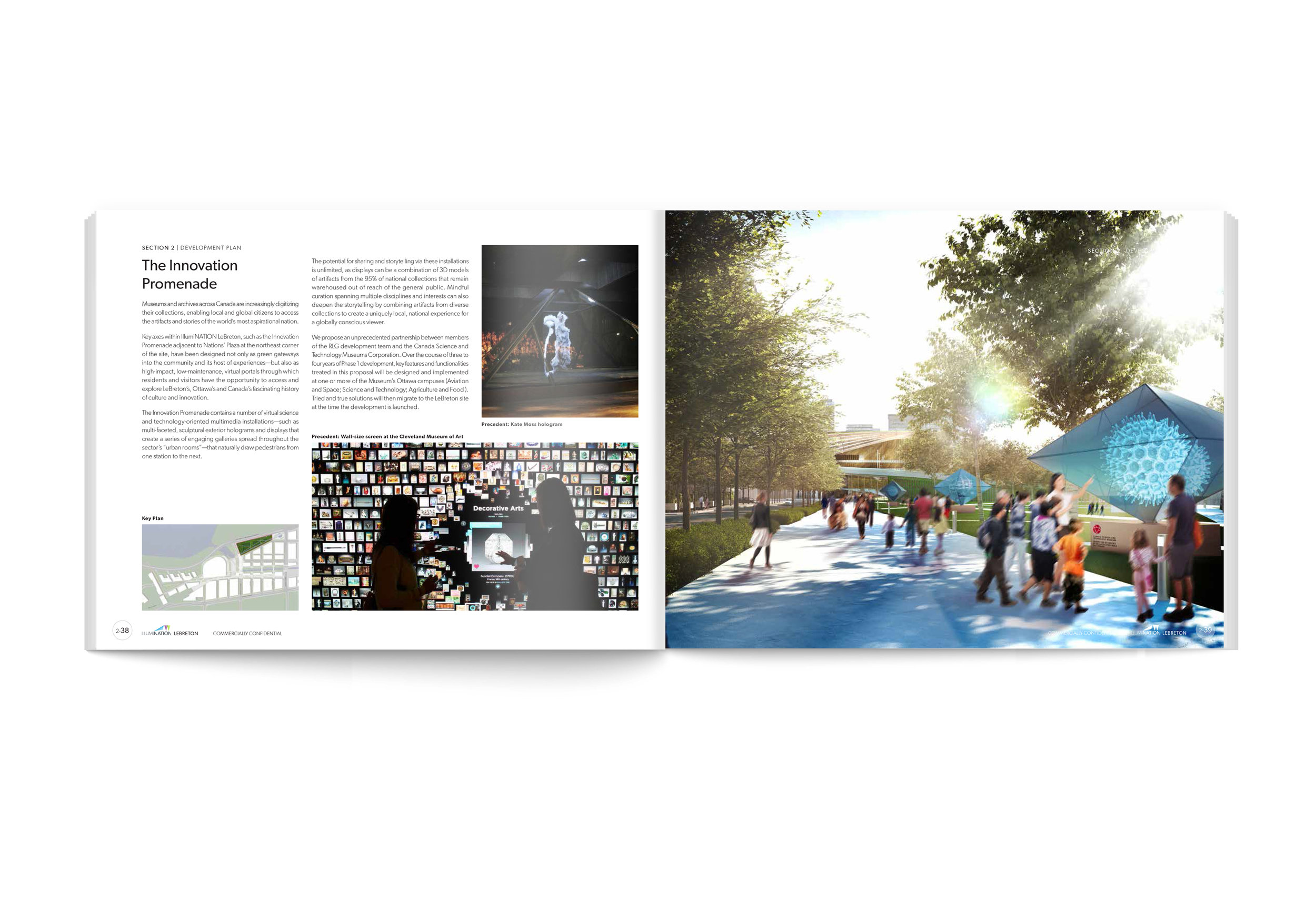The print projects we’re so proud of designing are merely attractive vessels for the content they contain—the words and images that tell a story. Storytelling is also known as creative writing and Aerographics offers these services for a wide range of requirements—from advertising and brochures to advertising and magazine articles to larger documents.
Game Set Match
Rossetti Architecture of Detroit, Michigan, is the world leader in sports and entertainment architecture and urban design. Their portfolio includes stadium projects around the world including Daytona International Speedway and the USTA’s Billie-Jean King National Tennis Centre in Flushing Meadows, New York. Rossetti produced a three-volume book called GAME SET MATCH for its USTA clients outlining the concept, development and completion of the massive US Open facility. Aero was contracted to write the first two volumes—GAME and SET.
Excerpt from Game Set Match
“It is no longer sufficient to simply design a visually pleasing structure to house sports activity, but rather to imagine a new broader experiential playing field upon which everyone participates—the players, the fans, the media, the sponsors and the community. Multi-layered environments that create these emotional memories are key to building and servicing committed and passionate fans and sponsors. In this way, the spirit of the place informs the emotions of the event.
Each project presents a distinct set of parameters, established goals, and a vision that can be deconstructed and then reimagined in ways that take the outcomes to places and heights never before dreamed of. This is the approach that ROSSETTI embraces with every project we undertake.
To do this means to push beyond comfort zones; to facilitate, through a series of “immersive Discovery Workshops,” the release of our clients’ imaginations from preconceived ideas about venue redevelopment and even the business of sport. In these collegial multi-day charrettes, ROSSETTI team members and clients are encouraged to think outside the bounds of their assumption, to put forth ideas, no matter how outlandish, to rethink age-old patterns of behaviors.
ROSSETTI’s strategy is to collaborate with visionary clients to design sports venues (and the spaces that link and support them) that inspire passion, evoke a sense of belonging and participation, and that provide newly imagined revenue generation.
Together with our partner clients, ROSSETTI works to uncover the underlying fundamental forces that have shaped their sport and brought their event to cultural and social preeminence. This process allows the Client/ROSSETTI team to discover hidden opportunities, imagine entirely new experiential patterns and begin to shape the design in multiple conceptual iterations, each of which is further shaped and influenced by market, cost, demographic and psychographic data.
The results of this reimagining are astonishing. We allow the clients to see beyond material elements or granular detail to envision potential leads to innovation, use design to leverage a competitive advantage for their franchise and demonstrate their leadership within the world of sports entertainment.
ROSSETTI’s unique approach to sports venue and experiential design has been honed over more than four decades of sport design and the successful completion of scores of innovative venues at the forefront of the field. This finely tuned approach, called Return on Design™, is more than just a catchphrase. It is the underlying principle of our approach to design, which recognizes that paradigm-shifting architectural design does not exist alone on an existential artistic plane, but is inextricably connected to and influenced by external social, market and fiscal forces. This strategic design process allows us to predict financial and experiential outcomes for each design that are founded in real world scenarios. Taking this approach, we have learned that even the most conservative of our clients feels more inspired to take on greater development risks if the design concept is founded on data-driven economics with clearly defined Return on Design™ investment.”
Seawolf: Adventure without Compromise — Charter yacht presentation booklet
The 193-foot long adventure super-yacht Seawolf offers its owner and charter clients extreme luxury and access to every corner of the world. With a live-aboard crew of 15 and luxury accommodations for the owner and 10 guests, Seawolf is designed for adventure in the world’s most remote locations—from Truk Lagoon to Haida Gwaii, from the Baltic Sea to the San Blas Archipelago, from San Tropez to Christchurch.
The owner hired Aero to write, design and produce a high-quality commemorative booklet for charter and personal guests that would tell the story of Seawolf’s extraordinary 60-year career on the oceans of the world.
Excerpt from Adventure without Compromise
“A Legend is Reborn
Although you would never think it today, Seawolf was once the hardest working ocean-going tugboat on the planet. Launched in the Netherlands in 1957 as Smit Clyde, Seawolf began a global career that would gain her the respect and admiration of mariners from Yokohama to Rotterdam. Her broad shoulders and steadfast heart enabled breathtaking nautical feats of strength and endurance. The most famous of these feats was her 1968 simultaneous tow of two United States Navy aircraft carriers from Boston to Japan. That power, that strength upon the oceans, is now at your disposal.
Seawolf was completely redesigned and rebuilt in 2002 for five-star leisure and adventure, and then in 2009, overhauled from her proud prow to her elegant fantail. Her recent refit makes her the finest adventure super-yacht extant. Your stay aboard Seawolf will create memories of a life of adventure and comfort for the rest of your life.
Where the Ordinary Ends and Adventure Begins
Adventure, it is said, is the pursuit of life. This spirit of adventure is at the heart of every day aboard Seawolf, whether you are swimming with humpback whales off the Costa Rican rain forest, exploring the breathtaking sea cliffs of Cape Formentor in the Balaerics or following in the footsteps of Darwin among the astounding creatures of the Galapagos Islands.
Seawolf is not only equipped to support any adventure anywhere on the planet, she does so without compromise. Her luxurious accommodations, salons and idyllic deck settings combined with fresh, locally supplied world cuisine, as well as her expert and adventurous crew, will make your journey aboard a story you will tell for the rest of your life.
All her life, Seawolf has been up to challenges and adventures on a global scale. Today, she brings with her unsurpassed luxury and comforts to enhance your experience and delight your guests.”
IllumiNATION LeBreton Response to the Request for Proposal
IllumiNATION Lebreton (Trinity Development Group/Senators Sports and Entertainment) was the winning proposal in the National Capital Commission’s competition to provide an urban design master plan for LeBreton Flats in downtown Ottawa. Aero was contracted to write and edit the core Main Submission document (250 pages) and edit, design and build the entire four-volume submission and presentation materials.
Excerpt from IllumiNATION LeBreton
“The proposal of the IllumiNATION LeBreton team is not one of simply redeveloping LeBreton Flats, but rather one that sparks a reawakening of the cultural, social and commercial life once found in this place. We will be bringing back to life a long dormant, historically important, culturally significant and socially vibrant neighbourhood and, through powerful cultural attractions, welcoming green spaces and dramatic harmonious urban design, keeping a promise made more than 60 years ago. To understand the way in which we will illuminate the history and the cultural significance of LeBreton Flats, it is important that our work find its place in the historical fabric of these waiting lands. It is important that we express our beliefs and passion for this place as an introductory part of this proposal, for in this expression we will find a foundation of the underlying beliefs and principles that define and give life to our ideas.
There are places in this world that are imbued with natural beauty, a spiritual power and emotional draw beyond their obvious utility. Most have been recognized as such and have come to underpin the world’s most energized, humanized, historic and compelling built environments—Quebec City, San Antonio’s Riverwalk and the canals of Amsterdam, to name but a few. These are places of exceptional natural wonder and beauty, evoking human emotion, historic drama, collective celebration, political tectonics—nexus points in a shared interaction of culture and nature. In them lives a soul—palpable, unavoidable and life-changing. Not all of these gathering places have reached their full potential. Some are yet to be discovered and some are deliberately held in extended stasis, their metabolisms slowed. LeBreton Flats, as part of the Chaudière Islands and the Parliamentary precinct, is one such place waiting to be rediscovered and revealed.”
Vintage News service from Vintage Wings of Canada
Since 2005, Dave O’Malley has been volunteering and working at Vintage Wings of Canada, a charitable foundation founded by high-tech entrepreneur and friend Michael U. Potter. Vintage Wings manages the events, commemorations and public outreach surrounding Potter’s world-class collection of vintage military aircraft, all of which are kept in perfect condition and flown by Canada’s most experienced warbird, military and test pilots.
Dave has created and managed the Vintage Wings brand for nearly 15 years, doing historical research, helping create outreach programs and managing content on the foundation’s website. The website offers a free story service, offering stories of aviation history and culture. Dave has written and published over 400 stories (totalling over 2.5 million words) about personal experiences of the heroes of the Second World War and other periods in Canadian, American and world aviation, as well as culture of the flying world.
Describing himself as a an “emotional historian,” Dave is less interested in the technical aspects of the machines and the geo-political tectonics of war fighting than telling the stories of the ordinary men and women who found themselves in the vortex of war. With over 16,000 subscribers from all over the world, Vintage News has received critical acclaim from warbird operators, pilots, veterans, the RCAF and serious military historians around the globe.
Excerpt from Death Came Knocking
“The neighbourhood I live in is called the Glebe. It's a funky 130-year-old urban community in Ottawa, Ontario, Canada—red brick Victorian homes, some stately, some working class, excellent schools as old as the neighbourhood, tall trees pleached over shady streets, open-minded and highly educated people, happy kids, diverse, desirable and timeless, close to everything, surrounded on three sides by the historic Rideau Canal. People come from all over the city, the country, even the world to walk its pathways, attend its festivals and sporting events and skate the canal. You may find a more upscale neighbourhood, a trendier one, a more affordable one, but you will never find a better one.
It is a truly perfect place to raise a family, build a business and live out a life as I have done. It is safe, historic, dynamic, walkable, serene and peaceful... but once it must have felt like the saddest place on earth. Its shady avenues ran with apprehension and despair, its busy serenity masked the constant high-frequency vibration of anxiety and the low pounding of sorrow. Behind every door and every drawn curtain hid anxious families. Behind many were broken parents, heartbroken wives, memories of summers past and lost, the promises of a future destroyed, children who would never know their fathers. These were the years of the Second World War and the decades following that it took to wash it all away.
There was nothing particularly special about the Glebe that brought this plague of anguish, nothing it deserved, nothing that warranted a special attention from death. Indeed, the Glebe was not singled out at all, though it may have felt like it. Every community in Canada and across the British Commonwealth took the same punishment, felt the blows to its heart, felt its life blood seeping away. During these six long years of war, every community across the land stood and took it, blow after blow after blow. Parents stood by while their sons and daughters left the family home, left the routines that gave comfort, the futures that beckoned and began arduous journeys that would, in time, lead most to war and great risk of death.
Some would die in training, others in transit. Some would die of disease and even murder. Some would die in accidents close to home, others deep in enemy lands. Some by friendly fire, others by great malice. Many would simply disappear with no known grave, lost to the sea, a cloud covered mountain, a blinding flash, a trackless jungle. Some would die in an instant, others with prolonged fear and pain. Most would make it home again. An extraordinarily high number would not come home in one piece.”



















